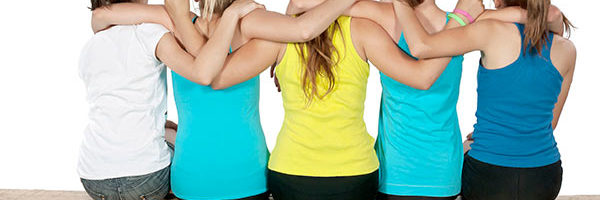
Pilates: Much More Than a Svelte Body
Over my 15 years of teaching Pilates, I have witnessed a tremendous leap in the number of individuals who have heard of the discipline. Yet many people still know very little about the full dimension of Pilates, and what they do know is frequently limited and sometimes even inaccurate. Basically, Pilates is a form of exercise designed to restore balance in the body. Joseph Pilates believed that in strengthening and stretching the body we can diminish many aches and pains and rehabilitate injuries. While this side of Pilates is becoming better known and many doctors are advising their patients to start practicing it, the idea that Pilates is simply about strengthening the “core” continues to be how most people think of it. But, when done properly and consistently, Pilates goes beyond strengthening the postural muscles to preventing sickness and reducing or even eliminating pain.
Pilates supports and promotes the body’s natural functions. In addition to strengthening muscles, Pilates helps the body fight off sickness and disease. Each Pilates exercise circulates the lymphatic fluid, which is a vital part of the immune system. (For example, the Rolling Like a Ball exercise boosts the movement of lymph as it massages the spine.) While all movement circulates the lymphatic fluid, the Pilates approach does so without adding stress to the body.
Pilates works on strengthening and stretching muscles within a safe range to avoid soreness or injury. We may not always think of a sore muscle or a nagging knee pain as stressing our body and impacting our overall health, but it does. Whether it is a common cold, an overworked muscle, or a chronic pain, our bodies have to direct energy and resources to these issues in an effort to heal. As a result, less energy and resources can be allocated to the other physiological processes within the body. In light of this, an exercise like Side Kicks, which safely strengthens the postural muscles and stretches the hamstrings, not only helps to reduce some forms of back pain, but it also increases the health of the entire body.
In fact, Pilates improves our health even when we might consider ourselves to be in good shape and injury-free. Within every body there are imbalances to some degree. Sitting in a car leads to a tightening of the muscles in the front of the body and an over-stretching of those in the back. Typing on a computer can cause the shoulders to round forward and over time produces a significant shift in posture. Carrying a purse, laptop case, or a child frequently causes the muscles on one side of the body to be stronger and the other side to be weaker. Such imbalances and misalignments can produce minor discomfort as well as lead to serious injuries.
Another advantage of practicing Pilates is the assurance that the flow of oxygen continues through each movement since every exercise has a suggested breathing pattern. A salient example of this is The Hundreds, which increases the circulation of oxygen in the blood as it warms up the body. Of course, there is also the virtue for which Pilates is best known: strong abdominals (given that every movement in Pilates starts at the “Powerhouse,” which comprises the group of muscles that run from the belly button to the pubic bone, around your waist, and the muscles of the upper back of the thigh, which are the external rotators of the hip). Throughout each exercise, we think of engaging these muscles in and up to stabilize the pelvis and elongate the spine. One of the ideal exercises for strengthening the Powerhouse is the Double Leg Stretch, which has the added benefits of stretching the chest and relieving stress.
To incorporate Pilates into your weekly activities, I suggest doing the full sequence, in order, three to five times per week. I also suggest using a Pilates mat, which is more cushioned, but a yoga mat or towel will work just as well as long as they are on carpeted floor.
Hundreds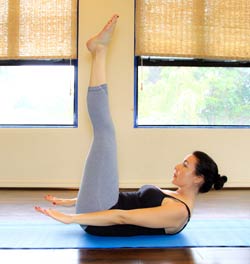
Setup: Lying on your back, extend your legs to the ceiling directly over your hips. Externally rotate your legs so that your heels are pressed firmly together and your big toes are about 4 fingers distance apart, a “V” position. Reach your arms straight by the sides of your torso. Lift your head and shoulders off the mat just to the point that the lower tips of your shoulders are still touching the mat. The upper abdominals should engage to hold your head up rather than the neck muscles.
Movement: Inhale for a count of 5 and then exhale for a count of 5 as you vigorously pump your straight arms 6-8 inches up and down from the starting point. Continue until you reach a count of 100, in other words 10 repetitions of this sequence. Think of your Powerhouse engaging in and up throughout the movement.
Notes: If you feel strain in your back or cannot fully extend your legs in this position, bend your knees to the point necessary while keeping your thighs over your hips. If you feel strain in your neck, put your head down but continue the exercise. Gradually increase the amount of time that you keep your head and shoulders lifted.
Rolling Like a Ball
Setup: Sit with your knees bent and shoulder width apart, hands placed on the shins, and feet in “V” position. Then balance back on your sacrum so that your feet are off the floor (as shown). Engage the Powerhouse in and up, and use that to lift yourself out of your hips as you round your spine evenly.
Movement: Initiating a change in your balance by pulling your Powerhouse in and up more, roll back to your shoulders (never onto your neck). Exhale and roll back up to the original position without letting your feet touch the floor. Repeat for a total of 10 repetitions.
Notes: It is important to keep your back rounded in order to roll. Work toward keeping your shoulders the same distance from your knees throughout the exercise by using your Powerhouse and by emphasizing the exhale on the return portion.
Double Leg Stretch
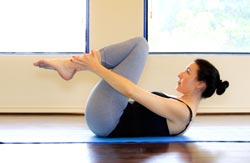
Setup: Lying on your back, engage your Powerhouse in and up to lift the head as in The Hundreds. Bend the knees into your chest and place your hands on your shins.
Movement: Inhale as you reach your arms straight back by your head and reach your legs straight out from the hips. Hold for 3 counts and pull your Powerhouse in and up more. Then circle your arms out to the side and around toward your legs as you pull the legs in from the Powerhouse, returning to the starting position. Keep your tailbone anchored on the mat. Repeat for a total of 5 repetitions.
Notes: Keep your upper back muscles pulled down your back to support the arms and engage the back of your legs in conjunction with your Powerhouse in order to keep your back anchored to the mat. Make sure that the torso and head do not move.
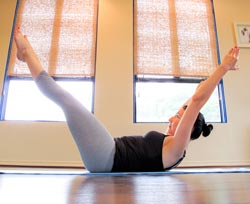
Side Kicks
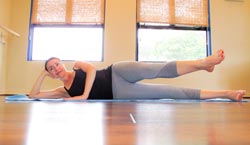 Setup: Lie on your side with your head propped up on your hand. Using the mat or towel as a guide, align your body, from your tailbone to your elbow, with the back edge of the mat. Then place the top hand on the mat as shown. The legs are straight and placed at the front end of the mat at a 30° to 40° angle from your torso. Lift the top leg to hip height and think of reaching it long away from your hips throughout the movement.
Setup: Lie on your side with your head propped up on your hand. Using the mat or towel as a guide, align your body, from your tailbone to your elbow, with the back edge of the mat. Then place the top hand on the mat as shown. The legs are straight and placed at the front end of the mat at a 30° to 40° angle from your torso. Lift the top leg to hip height and think of reaching it long away from your hips throughout the movement.
Movement: With control, inhale as you bring the top leg forward as far as possible (never farther than 90° from your hips). Then exhale and take the leg back (behind the resting leg) so that it is straight out from your hips. Repeat for 10 repetitions.
Notes: Watch that you do not let your body lean forward and back in counter balance of the leg. Use the Powerhouse to keep your torso perfectly still and to keep your waistline long on both sides.
ABOUT THE AUTHOR:
Marie Wittman is a Certified Pilates Instructor, a Senior Instructor Trainer, and owner of Art and Science of Balance, a company that provides education on healthy eating and Pilates. She also shares the amazing benefits of Pilates and how to rebalance the body from the inside out through exercise and nutrition at www.artandscienceofbalance.com. Photos by Neil Wittman – www.neilwittmanphotography.com.


